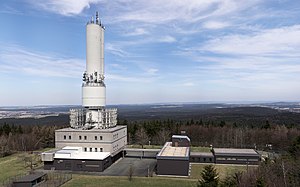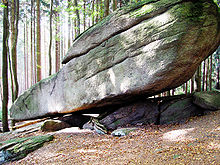Great Kornberg
| Great Kornberg | |
|---|---|
|
Former reconnaissance tower of the Bundeswehr on the mountain |
|
| height | 827 m above sea level NN |
| location | Bavaria , Germany |
| Mountains | Fichtel Mountains |
| Coordinates | 50 ° 10 '59 " N , 12 ° 1' 16" E |
| rock | granite |
| Age of the rock | variskish |
| particularities | Reconnaissance tower , Schönburgwarte ( AT ) |
The Große Kornberg with its 827 meter high summit is the north-eastern cornerstone of the Fichtelgebirge . It is the highest mountain on the wooded ridge of the Kornberg massif , which can be recognized from afar through the former reconnaissance tower of the Bundeswehr , and the local mountain of Schönwald and Schwarzenbach an der Saale . In terms of nature , it belongs to the main unit of the Hohes Fichtelgebirge (394). Since September 2010 there has been a new design of the natural areas of northeast Bavaria, according to which the Waldstein range (including the Kornberg) is an independent unit. The Rehau Forest connects to the northeast .
It consists of granite , which is coarse-grained in the lower layers and finer-grained in the upper layers. Opened quarries are evidence of the former handicraft of the stonemasons .
The Kornberg lacks the imposing rock towers and boulder seas , as one is used to from other mountain peaks in the Fichtelgebirge. However, the secondary summit Hirschstein has many steep, partly vertically sloping rock towers, there was the medieval castle of the same name, which has only been preserved in sparse remains. On the Kornberg there are other attractions, the gypsy stones with the rocking stone and the Schönburgwarte with a good view. A lift with floodlights is available for skiers .
Origin of name
An association with Korn may seem obvious at first glance, but this is a fallacy. For reasons of the rough and stony soil conditions, the Kornberg has most likely never been suitable for growing grain. Rather, in old documents you can read about a "Kurnberg". There are different explanations
for the word component Kurn . One refers to the Slavic kur for wood grouse , another to the Middle High German kurbe for curve . An early grain trade by some of the owners of Hirschstein Castle, on the other hand, seems rather unlikely. Most plausible, however, is the meaning of Mühlenberg from Middle High German kurn for mill . This is also indicated by the town of Mühlhausen, which was formerly located on the northwestern slope and was already desolate at the end of the 14th century. An explanation goes even further, according to which there is an incorrect transcription of the word myl as kurn (von mühl ). Here myl stands for cleared; The Kornberg is therefore a bare mountain that was previously forested. A passing old road ensured good transport conditions. The name Waldsteinerkette, used until the 19th century for the northwest flank of the Fichtelgebirge, has been forgotten and is no longer used.
The Schönburgwarte
The tower, inaugurated in 1954, is not the first structure on the Kornberg. In the autumn of 1849, the master carpenter Ulrich Hallmeyer from Kirchenlamitz erected a 70-foot high wooden tower on a stone foundation for land surveying. Twenty men worked on the structure for two weeks, which cost 460 guilders. When it became dilapidated, the Fichtelgebirge section of the German-Austrian Alpine Club (predecessor of the Fichtelgebirgsverein ) built a 23-meter-high wooden observation tower in 1885, which was planned by the building officer Winnerling, Wunsiedel. The construction was carried out by master carpenter Böhringer, Wunsiedel; the cost was 626 marks. The inauguration ceremony was on August 2, 1885.
Prince Ernst von Schönburg-Waldenburg donated the building site and the wood required, which is why the building was named Schönburgwarte. In March 1897 this wooden tower collapsed and in the course of the year the Fichtelgebirgsverein (FGV) decided to build a stone tower, which was planned in 1898 by the city building officer Thomas from Hof. Donations of money were collected; the Alpine Club Section Asch contributed 365 marks and the Vogtland Tourist Association 100 marks. Master builder Luding from Pilgramsreuth received the order to build the 19.2 meter high structure, which cost 7,800 marks.
On June 24, 1900, the stone rotunda was ceremoniously opened to the public. After a short time, repair work was necessary, because the tower showed serious cracks and had to be surrounded with iron rings. In 1930 part of the tower battlements had fallen and the stairway inside had to be repaired. Not a year went by in which the Schönburgwarte did not incur repair costs. In 1936 a professional investigation came to the result that the Kornberg tower had to make way for a new building due to its dilapidation. On December 4, 1938, the round tower was blown up for safety reasons. The new building planned by the FGV was to be called the Adolf Hitler Tower. Efforts for rapid rebuilding were thwarted by World War II.
On August 30, 1952, an association for the reconstruction of the Kornberg Tower was founded, which raised funds for a new observation tower on the Kornberg summit. Construction began as early as 23 August 1953 (planning: Oberstadtbaurat i. R. Rudorf, Hof; construction: Augsten & Scheuerlein, Hof). On October 10, 1954, around 4,000 hikers gathered for the ceremonial inauguration and handover of the tower to the public. The square tower with a total height of 26 meters, on which 114 stone steps lead, devoured 62,000 DM in construction costs, which were raised through donations and grants.
When the friends' association was dissolved, the Schönburgwarte was transferred to the Fichtelgebirgsverein on May 31, 1959. The surrounding FGV local groups Marktleuthen , Niederlamitz , Rehau , Schönwald , Schwarzenbach an der Saale , Selb and Selb-Plößberg took over the supervision of the tower. In 1960 members of the Niederlamitz FGV local group, with the support of the Reul-Granit AG company, installed a stone panorama pointer on the tower parapet. On the entrance side there is a large stone tablet with the data of the tower. In 1964, for the tenth anniversary of the tower, the Schönburgwarte received a tower ghost, a little man carved out of granite that stands in the tower entrance and bears the inscription “The tower ghost thanks for your donation”.
Hirschstein ruins
The Hirschstein Castle ( 744 m above sea level ) is located on the north path between the Kirchenlamitz -Ost train station and the Kornberg summit . The castle, of which there are only a few remains of the wall near a cliff, belonged to the von Hirschberg family . It was destroyed in the middle of the 14th century and not rebuilt, the Hirschberger relocated to Grünstein . During the Thirty Years' War , the ruins and vaults of the old castle served as a refuge for the rural people. On the orders of the margraves , the vaults were filled in in the 18th century because " gypsies " and "other light-shy rabble" had nested in them.
Gypsy stones
The granite rock group, a fine example of wool sack weathering , is located on the north path from the Kirchenlamitz-Ost train station to the summit on the western slope of the Kornberg. The largest block is about nine meters long, four to seven meters wide and two meters high; it should weigh 250 tons. A rock called Wackelstein can be made to wiggle with a wooden bolt. The area is said to have offered refuge for hordes of gypsies in ancient times. During the Thirty Years' War, the residents of the area also found shelter there.
Former reconnaissance tower of the Bundeswehr
The Kornberg is characterized by the reconnaissance tower of the Bundeswehr, which was built in 1973 and operated from 1976 . During the Cold War it was used to eavesdrop on the military radio communications of the Warsaw Pact land forces. The tower was operated by the telecommunications company 946, which was stationed in Hof / Saale . After the Soviet troops withdrew from the former GDR in 1994, the tower was decommissioned. Since then, it has been used by the Fraunhofer Institute for Integrated Circuits in Erlangen .
Two identical Bundeswehr listening systems were also located on surveys directly on the former NATO eastern border. These were plants near the GDR on the Hohe Meißner near Kassel (blown up in 2002) and in the north German lowlands on a 120 m high elevation in Barwedel in Lower Saxony.
literature
- Rainer H. Schmeissner: The Kornberg . Issue 4/1982 of the series of articles on the history and regional studies of the Fichtelgebirge. Kohler bookstore, Wunsiedel.
- Klaus Müller: The Great Kornberg - a high Bastey . Publishing house Gisela Arzberger, Selb-Oberweißbach 1997, ISBN 3-927313-18-1 .
- Dietmar Herrmann: The Great Kornberg . In: Der Siebenstern 2011, pp. 80–81.
- Dietmar Herrmann, Helmut Süssmann: Fichtel Mountains, Bavarian Vogtland, Steinwald, Bayreuther Land. Lexicon . Ackermannverlag, Hof (Saale) 2000, ISBN 3-929364-18-2 .
- Dietmar Herrmann: The Schönburgwarte on the Great Kornberg . In: Der Siebenstern 2014, issue 3, p. 92.
- Hans Bucka , Oskar Heland : Landmarks - corridor and small monuments in the district of Hof . Hoermann, Hof 1991, ISBN 3-88267-040-1 , pp. 71-76.
Individual evidence
- ^ E. Meynen and J. Schmithüsen : Handbook of the natural spatial structure of Germany - Federal Institute for Regional Studies, Remagen / Bad Godesberg 1953-1962 (9 deliveries in 8 books, updated map 1: 1,000,000 with main units 1960)
- ↑ Map services of the Federal Agency for Nature Conservation ( information )
- ^ Karl Heinrich Vollrath: Viola in Northeast Bavaria (page 132-133)
- ↑ Geodata with the BayernAtlas
- ↑ Klaus Müller: The Great Kornberg - "a high Bastey" . Gisela Arzberger, Selb-Oberweißbach 1997, ISBN 3-927313-18-1 , p. 9 f .
- ^ Heinrich Berghaus: The Fichtel Mountains and the Franconian Jura in: Deütschlands Höhen - Contributions to the exact knowledge of the same (1834), on books.google.de






